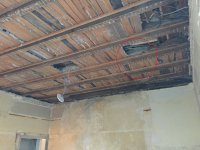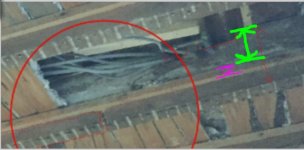Morning lads,
Took down the ceiling in one of the rooms we're away to decorate because 1) 100 year old wallpaper with various layers or paint beneath isn't fun to take off and 2) there was movement in the plaster that I thought was from it being detached from the lath behind it.
4 hours later and I'm left with a nice clear ceiling for plastering, BUT I've found a crack in a joist.
https://imgur.com/a/PK9MK (overview and closeups)
I've tried to highlight the width of the joist, the size of the notches near the crack and the size of the "sliver" that' cracked along the beam in this image:

Because the lath was attached to the bottom of the joist (and that long sliver of wood has cracked off the joist) that's what was causing the movement.
What's the best way to tackle this? Just a massive bracing/sister piece?
Americans seem to sister joists with ply, construction adhesive and nails. Brits seem to favor larger joists that get bolted on.
Took down the ceiling in one of the rooms we're away to decorate because 1) 100 year old wallpaper with various layers or paint beneath isn't fun to take off and 2) there was movement in the plaster that I thought was from it being detached from the lath behind it.
4 hours later and I'm left with a nice clear ceiling for plastering, BUT I've found a crack in a joist.
https://imgur.com/a/PK9MK (overview and closeups)
I've tried to highlight the width of the joist, the size of the notches near the crack and the size of the "sliver" that' cracked along the beam in this image:

Because the lath was attached to the bottom of the joist (and that long sliver of wood has cracked off the joist) that's what was causing the movement.
What's the best way to tackle this? Just a massive bracing/sister piece?
Americans seem to sister joists with ply, construction adhesive and nails. Brits seem to favor larger joists that get bolted on.




